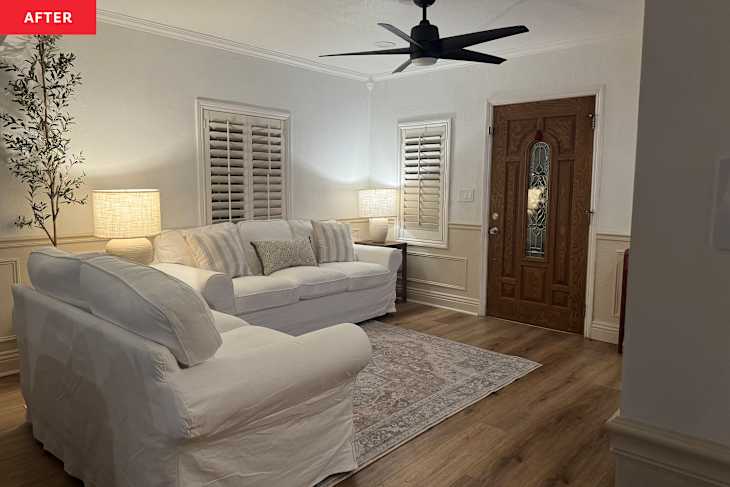Transforming Awkward Spaces: How One Designer Made a Narrow Living Room Feel Triple the Size
Introduction: A Remarkable Home Transformation
In the world of interior design, even the most challenging spaces can be turned into stunning showcases of style and functionality. Recently, a homeowner took a bold step by sending photos of their awkward, narrow living room to a designer. The result? A stunning transformation that made the space feel three times larger than its original size. Let’s delve into the design strategies employed to achieve this remarkable makeover.

Design Strategies That Enhance Space Perception
Creating an illusion of space in narrow or awkwardly shaped rooms requires a keen understanding of design principles. Here are key strategies that significantly contributed to the transformation of this living room.
1. Optimizing Furniture Placement for Flow and Movement
A fundamental step in enhancing a room’s spaciousness is ensuring clear pathways for movement. By arranging furniture to facilitate easy interaction and flow, the homeowner was able to foster a sense of openness. This design approach allows individuals to navigate the space comfortably, preventing a cluttered feel.
According to an article on Schaeffer Homes, flow and movement are crucial components in room design. By strategically positioning furnishings, it’s possible to create an environment that feels more expansive while remaining functional.
2. Creating Distinct Zones with Room Dividers
In spaces where the layout may be awkward, room dividers can be used to create distinct areas, encouraging organization and flow. This technique is particularly useful in open-concept spaces, allowing for a more structured appearance without compromising on openness. The designer likely incorporated room dividers, such as shelves or curtains, to enhance the layout and maximize the sense of space.
3. Color Scheme and Lighting: Influencing Atmosphere
Color Psychology: The Power of Light Hues
Color selection plays a pivotal role in how spaces are perceived. Lighter shades on walls and floors can create a sense of openness, making a room feel more inviting and larger. Shades like soft whites, light grays, or pastels are often utilized in narrow spaces to reflect more light and contribute to a bright atmosphere.
In a study shared by Decorating Den, the significance of color psychology in interior design is emphasized. Choosing the right palette can dramatically influence the mood and perceived size of a room.
Lighting Techniques: Illumination Matters
In addition to color, effective lighting can dramatically enhance spatial perception. By illuminating corners and reducing shadows, proper lighting ensures that every inch of the room is highlighted. This creates an inviting environment that feels spacious rather than cramped. Designers often recommend layering light through fixtures, floor lamps, and ambient lighting to achieve this desired effect.

4. Mirrors and Reflections: Creating Illusions of Depth
Strategically placed mirrors can work wonders in expanding the visual space in any room. They reflect light and create the illusion of depth, which can significantly enhance the feeling of spaciousness. Designers often suggest placing mirrors opposite windows or light sources to maximize these effects.
The Psychology of Interior Design details how reflections can alter perceptions of a room, contributing to an overall sense of openness and freshness.
5. Minimizing Clutter: The Key to Spaciousness
A clutter-free environment is essential for improved space perception. The homeowner’s designer likely implemented strategies to minimize excess items, ensuring the living room felt organized and expansive. According to various design experts, a tidy space allows for an uncluttered mindset and enhances the overall aesthetic.
It’s widely recognized that clutter can overwhelm a room, making it feel smaller. Embracing minimalism through de-cluttering can alleviate this sensation and encourage a more welcoming atmosphere, as noted in Hallmark Homes Group.
6. Rearranging Layouts for Optimal Flow
Sometimes, a simple rearrangement is all it takes to improve a room’s fluidity. By experimenting with furniture placement at various angles or introducing round shapes to soften corners, the homeowner could create a layout that feels more spacious and inviting. This adjustment not only made movement easier but also introduced a refreshing dynamism to the space.
Interior designers often advocate for rethinking layouts, as discussed in Emily Henderson Blog, reinforcing that even minor changes can yield significant improvements in function and perception.
Credit: Stephanie Montes

Conclusion: The Power of Design in Enhancing Living Spaces
The transformation of this narrow living room into a spacious sanctuary showcases the profound impact of thoughtful interior design. By incorporating deliberate strategies surrounding furniture arrangement, color psychology, lighting, and minimalism, the homeowner successfully enhanced their living space, resulting in an environment that feels both expansive and inviting. Such transformations highlight the importance of collaboration with design professionals to unlock the fullest potential of our homes.
For more insights and inspiration on designing your own spaces, consider exploring additional resources on Apartment Therapy. As our homes continue to shape our lives and moods, the right design choices make all the difference.


